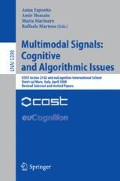Abstract
After perceiving multi-modal behaviour from a user or agent a conversational agent needs to be able to determine what was intended with that behaviour. Contextual variables play an important role in this process. We discuss the concept of context and its role in interpretation, analysing a number of examples. We show how in these cases contextual variables are needed to disambiguate multi-modal behaviours. Finally we present some basic categories in which these contextual variables can be divided.
Access this chapter
Tax calculation will be finalised at checkout
Purchases are for personal use only
Preview
Unable to display preview. Download preview PDF.
References
Beavin Bavelas, J., Coates, L., Johnson, T.: Listener responses as a collaborative process: The role of gaze. Journal of Communication 52, 566–580 (2002)
Cassell, J., Bickmore, T., Billinghurst, M., Campbell, L., Chang, K., Vilhjálmsson, H., Yan, H.: Embodiment in conversational interfaces: Rea. In: Proceedings of the SIGCHI conference on Human factors in computing systems: the CHI is the limit, Pittsburgh, Pennsylvania, United States, pp. 520–527. ACM, New York (1999)
Cassell, J., Sullivan, J., Prevost, S., Churchill, E.F. (eds.): Embodied Conversational Agents. MIT Press, Cambridge (2000)
Clark, H.H.: Using Language. Cambridge University Press, Cambridge (1996)
Ekman, P., Friesen, W.V.: The repertoire of nonverbal behavior: Categories, origins, usage, and coding, semiotical. Semiotica 1, 49–98 (1969)
Ekman, P.: About brows: Emotional and conversational signals, pp. 169–202. Cambridge University Press, Cambridge (1979)
Halliday, M.A.K., Hasan, R.: Cohesion in English. Longman Pub. Group (May 1976); published: Paperback
Heylen, D.: Challenges ahead: Head movements and other social acts in conversations. In: Halle, L., Wallis, P., Woods, S., Marsella, S., Pelachaud, C., Heylen, D. (eds.) AISB 2005 Social Intelligence and Interaction in Animals, Robots and Agents, pp. 45–52. The Society for the Study of Artificial Intelligence and the Simulation of Behaviour, Hatfield (2005)
Lyons, J.: Introduction to Theoretical Linguistics. University Press, Cambridge (1968)
Nakano, Y.I., Reinstein, G., Stocky, T., Cassell, J.: Towards a model of face-to-face grounding. In: ACL 2003: Proceedings of the 41st Annual Meeting on Association for Computational Linguistics, Morristown, NJ, USA, vol. 1, pp. 553–561. Association for Computational Linguistics (2003)
Samtani, P., Valente, A., Johnson, W.L.: Applying the saiba framework to the tactical language and culture training system. In: Padgham, Parkes, Mũller, Parsons (eds.) 7th Int. Conf. on Autonomous Agents and Multiagent Systems (AAMAS 2008), Estoril, Portugal (May 2008)
ten Bosch, L., Oostdijk, N., de Ruiter, J.P.: Durational aspects of turn-taking in spontaneous face-to-face and telephone dialogues. In: Sojka, P., Kopeček, I., Pala, K. (eds.) TSD 2004. LNCS, vol. 3206, pp. 563–570. Springer, Heidelberg (2004)
Author information
Authors and Affiliations
Editor information
Editors and Affiliations
Rights and permissions
Copyright information
© 2009 Springer-Verlag Berlin Heidelberg
About this paper
Cite this paper
ter Maat, M., Heylen, D. (2009). Using Context to Disambiguate Communicative Signals. In: Esposito, A., Hussain, A., Marinaro, M., Martone, R. (eds) Multimodal Signals: Cognitive and Algorithmic Issues. Lecture Notes in Computer Science(), vol 5398. Springer, Berlin, Heidelberg. https://doi.org/10.1007/978-3-642-00525-1_6
Download citation
DOI: https://doi.org/10.1007/978-3-642-00525-1_6
Publisher Name: Springer, Berlin, Heidelberg
Print ISBN: 978-3-642-00524-4
Online ISBN: 978-3-642-00525-1
eBook Packages: Computer ScienceComputer Science (R0)

